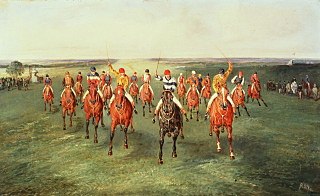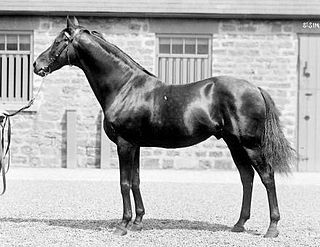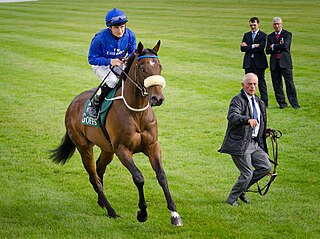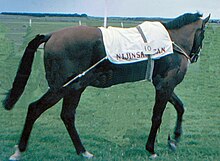
The Triple Crown of Thoroughbred Racing, often shortened to Triple Crown, is a series of horse races for Thoroughbreds, often restricted to three-year-olds. Winning all three of these Thoroughbred horse races is considered the greatest accomplishment in Thoroughbred racing. The term originated in mid-19th-century England and nations where Thoroughbred racing is popular each have their own Triple Crown series.

Nijinsky was a Canadian-bred, Irish-trained champion Thoroughbred racehorse and sire. He was the outstanding two-year-old in Europe in 1969 when he was unbeaten in five races. In the following season, he became the first horse for thirty-five years to win the English Triple Crown, a feat that has not been repeated as of 2023. He is regarded as one of the greatest European flat racehorses of the 20th century.

The 2000 Guineas Stakes is a Group 1 flat race in Great Britain open to three-year-old thoroughbred colts and fillies. It is run on the Rowley Mile at Newmarket over a distance of 1 mile (1.6 km) and scheduled to take place each year at the start of May.

The St Leger Stakes is a Group 1 flat horse race in Great Britain open to three-year-old thoroughbred colts and fillies. It is run at Doncaster over a distance of 1 mile, 6 furlongs and 115 yards, and it is scheduled to take place each year in September.
The 1000 Guineas Stakes is a Group 1 flat horse race in Great Britain open to three-year-old fillies. It is run on the Rowley Mile at Newmarket over a distance of 1 mile, and it is scheduled to take place each year in late April or early May on the Sunday following the 2000 Guineas Stakes.

The Oaks Stakes is a Group 1 flat horse race in Great Britain open to three-year-old fillies. It is run at Epsom Downs over a distance of 1 mile, 4 furlongs and 6 yards, about 1½ miles, and it is scheduled to take place each year in late May or early June. It is the second-oldest of the five Classic races, after the St Leger. Officially the Betfred Oaks, it is also popularly known as simply The Oaks. It has increasingly come to be referred to as the Epsom Oaks in both the UK and overseas countries, although 'Epsom' is not part of the official title of the race.)

St. Simon was an undefeated British Thoroughbred racehorse and one of the most successful sires in the history of the Thoroughbred. In May 1886 The Sporting Times' carried out a poll of one hundred experts to create a ranking of the best British racehorses of the 19th century. St. Simon was ranked fourth, having been placed in the top ten by 53 of the contributors.

Bayardo (1906–1917) was a British bred Thoroughbred racehorse with an impressive record, both on the racecourse and at stud, where he was a leading sire.

Alec Taylor Jr. (1862–1943), known as the Wizard of Manton, was a British Thoroughbred racehorse trainer who followed in the footsteps of his highly successful father, Alec Taylor Sr.

Gainsborough (1915–1945) was a British bred Thoroughbred racehorse who won the English Triple Crown in 1918 and became a superior sire.

Sir Peter Teazle was a good British bred Thoroughbred racehorse, a Leading sire in Great Britain & Ireland nine times, and carried on the sire line of Herod.

Sceptre (1899–1926) was a British-bred and British-trained Thoroughbred racemare whose career ran from 1901 to 1904. In 1902, she became the only racehorse to win four British Classic Races outright.

Pommern (1912–1935) was a British bred Thoroughbred racehorse and sire. In a racing career which lasted from 1914 to June 1916 he ran ten times and won seven races. As a three-year-old in 1915 he won the 2000 Guineas at Newmarket and the wartime substitutes for The Derby and the St. Leger Stakes to win a version of the English Triple Crown. After winning his only race as a four-year-old in 1916, he was retired to stud where he had limited success.

Swynford was a British Thoroughbred racehorse. Bred at the 16th Lord Derby's stud in Lincolnshire, England he was sired by John O'Gaunt, a son of Isinglass, winner of the British Triple Crown in 1893. His dam was Lord Derby's foundation mare and 1896 Epsom Oaks winner Canterbury Pilgrim who also produced Chaucer, the 1927 and 1933 Leading broodmare sire in Great Britain & Ireland.

Crucifix (1837–1857) was an undefeated, Classic Race winning, British-bred Thoroughbred racemare. She was also the dam of three sires who had a great influence on the breed.

Camelot is a British-bred, Irish-trained thoroughbred racehorse. He was one of the leading European two-year-olds of 2011 and won the Racing Post Trophy at Doncaster. On his three-year-old debut in 2012, Camelot won the 2000 Guineas at Newmarket and followed up by winning the Derby at Epsom and the Irish Derby at the Curragh. His bid for the Triple Crown failed narrowly when he finished runner-up in the St Leger.

Formosa (1865–1881) was a British Thoroughbred racehorse that was the first winner of the English Fillies Triple Crown in addition to running a dead heat with the colt Moslem for the 2,000 Guineas Stakes. Formosa was bred by James Cookson and was foaled in 1865 at his Neasham Hall stud farm. Formosa was sold to William Graham in 1866 and raced her entire three-year racing career under his ownership. After her racing career ended in 1871, she became a broodmare for Graham until his death in 1876. Formosa was exported to France in 1879 and died there in February 1881. While she did not produce offspring that excelled at racing, her daughters that were exported to Germany and New Zealand did produce descendants that were successful racers.

Encke was an American-bred, British-trained Thoroughbred racehorse, best known for winning the classic St Leger Stakes at Doncaster Racecourse on 15 September 2012 when he defeated the Triple Crown bid of Camelot. In spring of 2013 Encke was banned from racing after failing a drug test. He returned to racing in 2014 and was placed in three races including the Irish St. Leger. He sustained a fatal injury in training in October 2014.
Garden Path was a British Thoroughbred racehorse and broodmare who won the classic 2000 Guineas in 1944. In a racing career conducted entirely at Newmarket Racecourse the filly ran six times and won three races. She was one of the best British two-year-olds of 1943, when she won one race and was placed in both the Middle Park Stakes and the Cheveley Park Stakes. After winning on her first appearance of 1944 she became the first filly since 1902 to win the 2000 Guineas against colts. On her only subsequent race she was injured when finishing unplaced in the Derby. She was retired from racing at the end of the season and had some success as a broodmare.
Walter Earl (1890–1950) was a British Thoroughbred racehorse trainer. After a riding career of limited importance he became a private trainer, first for Solomon Joel and later for Lord Derby. He was one of the most successful trainers of the 1940s, sending out the winners of six classics and winning the title of Champion Trainer in 1945. His best horse was Alycidon who won the Ascot Gold Cup in 1949.


















